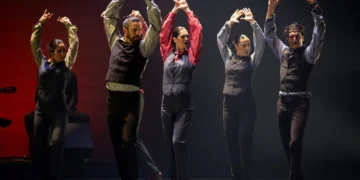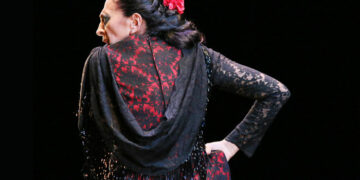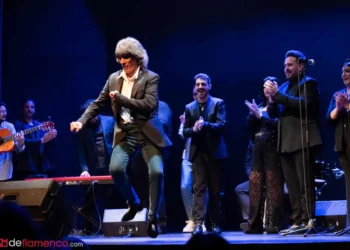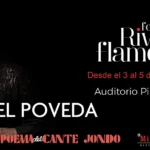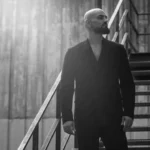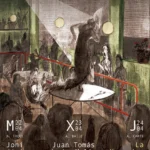|
|
||||
|
Special XIII Festival de Jerez 2009. All the information Photos: Ana Palma Photo gallery CARMEN INIESTA “Fuente del berro” Dance: Carmen Iniesta; Cante: Paco el Trini, Gori Muñoz; Guitar: Rubén Martínez, Eduardo Pacheco; Violin: David Moñiz Text: Manuel Moraga In the early evening of Thursday, we were able to enjoy the presence of two women dancers. The enjoyable moments when Carmen Iniesta secluded herself in the Madrid park La Fuente del Berro when she was studying in the capital, are the central theme this dancer used to build her simple but interesting show, where her particular personality can be seen from the first moment. She has wonderful details, originality in the staging and a balanced way of presenting her theme. She works the castanets with elegance and a sense of drama. She composes her stylized figure and doesn’t overdo anything, especially footwork, thus managing to keep the dances from being unnecessarily long. Nor is she a dancer seduced by special effects and flourishes. She knows how to stand still and not be carried away by spectacular athletics that are so popular in flamenco dance today. The result is a crafty way of managing time. A smooth movement of ideas wrapped in an interesting presentation. All done professionally, with originality and above all, naturalness. Carmen Iniesta doesn’t need to tell about her inner search while standing under a bare lightbulb hanging from the ceiling. She did her psychoanalisis on her own time, at home, and brought the final results to the stage. COMPAÑÍA DE DANZA FLAMENCA CARMEN CORTÉS “Mujeres de Lorca” Dance: Carmen Cortés; Corps de ballet: Trinidaz Artíguez, Virginia Murcia, Tamar González, Laura Cantero, Carmen Lozano, Fernanda Borria, Silvia Rincón; Cante: Guadiana, Salvador Barrull, Charo Manzano, Carmen Carmona; Guitar: Jesús de Rosario, Iván Losada; Percussion: Ángel Sánchez “Cepillo” The center of attention was Carmen Cortés who brought her work “Mujeres de Lorca” to the Festival de Jerez. It’s a somewhat uneven theatrical exercise. The overall idea is original, there are some important moments, magnificent work on the part of the musicians, interesting staging, some thoroughly unconventional choreographic details… But? But the show did not manage to maintain the emotional pace. Carmen Cortés has plenty of the necessary theatrical savvy in terms of dance, following the line she learned from Mario Maya. In that sense, the professionalism with which the work is presented, is on full display. Everything is studied and coordinated around a central idea, which is women as presented in the works of Lorca. Nevertheless, one of the difficulties is the need to create a space where those different women from often disparate works such as Mariana Pineda, Yerma and La Zapatera Prodigiosa can cohabit. The spectator can’t resist accepting a stage full of old shoes as a Lorca space. Nor is there any problem with the different ways in which each of the dramas is individually represented. But the bottom line is, “Mujeres de Lorca” doesn’t hold up on stage. What starts out stimulating curiosity, ends up giving you a feeling of relief when the show finally ends. In my opinion, it’s the dramatic pace that fails. In other words, the level of intensity throughout the show clearly needs to be improved. Aside from this, it’s only fair to highlight the work of Carmen Cortés. In the first place, we must consider the difficulty of managing a privately-funded company of this nature, representing theater combined with dance. Furthermore, Carmen Cortés is concerned with taking on complex works such as those of Cernuda, Bergamín, Alberti and of course, Lorca. Thirdly, this choreography feels and expresses a commitment to the language of dance which makes it reject easy applause, so easy to elicit, really. And as if all that weren’t enough, Carmen Cortés lays out a very personal dance style of her own. Distancing herself from mere vertical poses transmits a constantly unsettling feeling; her twisted postures and her physical instability transmit an interesting sort of psychological alteration that goes well with Lorca’s themes regarding women and maternity. Carmen’s dancing, half-way between earthy and irrational, is truly stimulating. SPECIAL STUDIES MARIO MAYA Yesterday the Jornadas Técnicas devoted to Mario Maya came to a close with the presentation of the Foundation that bears the name of this creator of flamenco dance. José Yáñez, Vice-president and spokesman for the Foundation, put forth the most important objectives, as well as agreements with cities such as Córdoba, Granada and Seville to house offices. The Granada municipal government has ceded La Chumbera to be a center of dance and theater studies to be directed by Belén Maya “to follow in the lines of integrated preparation that my father always defended” said the dancer. Ostalinda Maya, another of the maestro’s daughters who was present, will be in charge of the Human Rights Department of the Mario Maya Foundation. Ostalinda is an anthropologist who runs the Women’s Area of the Central European Gypsies’ Organization. Mario Maya’s son will be in charge of the Foundation’s documentation. Among the many projects of this entity, and in view of Mario Maya’s cultural militancy, the organization has planned an itinerant painting exhibit which for the moment includes the work of artists such as Eduardo Arroyo, Antonio Maya and Antón Lamazares. Special XIII Festival de Jerez 2009. All the information Photos: Ana Palma Photo gallery |



 XIII FESTIVAL DE JEREZ 2009
XIII FESTIVAL DE JEREZ 2009 



